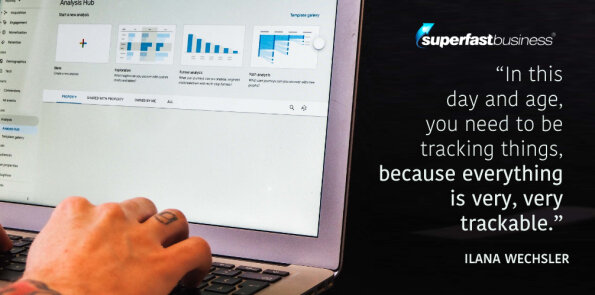Podcast: Download (Duration: 27:15 — 25.1MB)
Get Notified Of Future Episodes Apple Podcasts | Spotify | Amazon Music | Android | Blubrry | Gaana | TuneIn | Deezer | Anghami | RSS | More
In the podcast:
Business owners typically make one of these two tracking mistakes. [01:10]
Tracking is about data – so what insights into it can a former data analyst like Ilana provide? [02:47]
For people who think data tracking is difficult, there are a couple of tools that can help. [03:52]
Which of your traffic channels bring in the people, and do they convert? [05:51]
If you’re spending money on ads, this is one of the key website metrics you really need to track. [09:23]
Where are people dropping off your funnel? [13:21]
Compare someone who’s never been to your website with a return visitor. [14:33]
Have you a blog generating SEO traffic? Check out this metric. [17:10]
What age and gender are the people who buy most from you? [19:46]
The current surge in mobile usage cannot be ignored if you want your online business to succeed. [21:57]
Need a leg up in your marketing? James can help
A question James gets asked a lot is, what should I be tracking? And, Do you have a dashboard? If you do have a dashboard, what should be on it? What can we use for a dashboard?
The two tracking mistakes business owners commit
Unfortunately, he says, a lot of business owners aren’t tracking anything. And when they are, sometimes they are over-tracking, measuring so many things that it’s meaningless.
James has actually let go of some tracking tools that were too comprehensive, where he didn’t even understand what he was looking at.
What he would like is a happy medium, a Goldilocks version, if you will, of the key website metrics a business owner should be tracking.
With that in mind, he’s engaged Ilana Wechsler of TeachTraffic.com to distill the essentials into the seven metrics she thinks will provide the information a business owner needs to run and optimize their online business.
A former data analyst’s take on tracking
Ilana is happy to oblige. In this day and age, she says, you need to be tracking things, because everything is very, very trackable. And the future of your business could hinge on you measuring and acting on the right things.
“There’s certain data that’s better than others. – James Schramko”
As a former data analyst, says James, Ilana probably takes it for granted that we should have data. For many of us, the first step is knowing that data is good to have. And then beyond that, there’s certain data that’s better than others, and that’s what we should focus on.
The seven metrics that Ilana will discuss are a great starting base to which we can add or subtract as needs be.
 Having taught Google Analytics at Sydney University, Ilana can appreciate the aversion most people have to looking at data. This is why she thinks it’s so important to just focus on the metrics that are really, really important and not get overwhelmed with what this little thing means or that little thing means.
Having taught Google Analytics at Sydney University, Ilana can appreciate the aversion most people have to looking at data. This is why she thinks it’s so important to just focus on the metrics that are really, really important and not get overwhelmed with what this little thing means or that little thing means.
The tools that make it easier
To make analytics more palatable, says Ilana, there are now dashboards available which are a template that just feeds in the data automatically. You literally just plug your Analytics account into the back end of it, and the data pops up.
What is Ilana using for that, asks James?
Her favorite is a free tool called Google Data Studio. Because it’s a free Google product, it talks beautifully with Google Analytics. They use Google Analytics, she says, as their source of truth for data. Obviously, for that, you need to have your Google Analytics account set up properly. But Data Studio is such a fantastic tool because it can incorporate other platforms as well.
For example, if you’re running Facebook ads, with a connector, you can connect your Facebook Ad Account to Google Data Studio to feed in your spend and conversions and so on, so you can really have a dashboard that feeds in data from multiple sources, and create something that is really, really useful for you and your business. And it populates automatically. So once you set it up, you change the date range, and the data automatically populates.
This is what Ilana helps people do in Teach Traffic.
The first metric you want to see
So what’s the first metric Ilana likes to see on a dashboard?
The first thing she always looks at is what’s called the traffic source report. But ideally, what she’s looking for is the conversion rate of each individual traffic source.
So when you log into Analytics, or if you’ve set up the Data Studio report that feeds in this report from Analytics, it’s going to have a table that says, Google organic, Google/CPC. CPC is Google ad traffic, direct traffic. And so you want to rank by the portion of your overall users per traffic source, but then correspond that with the conversion rates.
What you’re trying to understand is, where is the majority of your traffic coming from? What is the source of the majority of your traffic? And does it convert?
So if your Google organic traffic is the highest traffic source in terms of the number of people coming, but the conversion rate is actually quite low, then that warrants further investigation. But really, overall, you want to look at your overall traffic sources, and how they are converting.
Another example would be, if you see that your Google CPC traffic, which is your Google ad traffic, is owning, say, a fifth of your overall traffic, but it accounts for 70 percent of sales, that indicates that it actually converts really well, and you need to give it a little bit more attention.
On the flip side, if it accounts for only five percent of sales, it’s not converting very well and you need to diagnose the traffic.
What kind of return are you getting?
The second key metric relates to people spending money on ads, which is the return on ad spend, or ROAS. For lead gen people, that would be cost per acquisition.
“We live in an era where it is multi-device and multi-platform. – Ilana Wechsler”
Now Ilana believes that in 2022, at time of recording, we live in an era where it is multi-device and multi-platform. For instance, someone might see a Facebook ad, and then Google-search the business to verify if it’s legit.
So there’s this concept of direct return on ad spend, the return as a result of directly ad spend, which is what the ad platforms report, versus a blended ROAS, which is, what have you made overall, revenue-wise from all your traffic sources, divided by, what have you spent in total?
Ilana likes to report on both these elements, the direct ROAS versus the blended ROAS. And truthfully, she thinks the truth lies somewhere in between those metrics.
Is the funnel your goal?
The third thing Ilana personally loves looking at is where or if people drop off in a funnel. If you’ve set up a funnel as your goal in the admin section of Analytics, Analytics reports on how people have progressed through that funnel.
This is like an extra step that you do need to set up, says Ilana. So for e-commerce, step one of the funnel might be landing on the homepage, step two would be landing on the product page, step three would be adding to the cart, step four would be checkout, and so forth. And you can see the drop-off points.
Visually, she says, this is very powerful. You can actually see where your bucket or funnel is leaking people out. And while it takes an extra step, it’s a treasure trove of information.
Newcomers versus return visitors
The number four metric Ilana wants people to look at is a funnel comparison of new versus returning visitors. It’s like a segment within a segment to some degree. You want to compare the behavior of someone who’s never come to the website before to that of a return visitor. And obviously, return visitors convert higher.
But then you want to see the funnel of new versus returning people. And ideally, what you want to see is that your funnel is doing its job of converting new people. And you want to compare the funnel conversion rate for new people versus returning.
If your funnel for new visitors isn’t converting, it might be you have to improve the copy on your landing page or the product pages. You maybe have to add reviews, or have copy that’s more benefit-driven rather than feature-driven. Maybe add a video. It’s just trying to improve the overall conversion rate.
The pages that bring in and convert people
It could also be a function of traffic, which leads Ilana to the next metric, which is the pages people enter on and if they convert. Specifically, these are for businesses that have a blog, that generate SEO traffic.
Ilana is helping someone at present who gets 28 percent of their overall traffic from a single blog post. But it only converts at .04 percent.
What to do? A few things, says Ilana. You could possibly change the copy on that blog post, leverage the 28 percent of traffic that is coming onto the page. Whatever you could do to convince them to buy your product.
Or it might be diluting your retargeting lists and maybe excluding the people who’ve entered on the page and for whatever reason don’t convert. Whatever it is, you definitely want to see what pages people are entering on and how they perform.
This has come up in dealings with Gert from seoleverage.com, says James. He sees sometimes that they get a lot of traffic to a page, but it doesn’t do what they want it to. So they rewrite it, update it, or add elements.
Ilana is a big believer in the 80:20. If a large portion of your traffic is coming on one page, rather than updating all your blog content, better to work through the page or pages that get the most visitors, and move the needle that way.
What age and gender are your best customers?
Another thing Ilana likes to look at is demographics. Is there a certain segment of age or gender that converts so well that, if you’re running, say, Facebook ads, you can just focus on that area of the market?
One person Ilana is helping sells a product for home office, and 75 percent of their transactions are from men, according to Analytics. The data’s not foolproof, but 75 percent is high enough to be worth targeting that end of the market with Facebook ads.
So you match up age and gender to our targeting, says James. And might there be certain platforms that work better for different genders?
Yeah, says Ilana. If you have a very female market, you might focus on Pinterest. But then she would also go back to the traffic sources report. How is the Pinterest traffic, and does it convert?
Obviously, too, it’s not just about conversions. Also look at, do people bounce straightaway? Do they view more than one page? What’s the quality of the traffic? That’s really what you want to look at. Are they engaged visitors?
Pay attention to your mobile traffic conversions
For number seven, Ilana believes in 2022 we need to focus on how our mobile traffic is converting. People are doing more and more everyday stuff on their mobile phones. So Ilana personally likes to see the proportion of traffic that is from a mobile and how that traffic converts.
If 80 percent of your traffic is mobile, but it has a very, very low conversion rate compared to desktop, then possibly the mobile experience isn’t very good for people, and you need to create a better mobile-optimized site.
Ilana suggests installing some heat-mapping software like Hotjar. You could get a free account, set up the recordings, and watch to see what the user experience is like for people.
Mobile is only getting bigger and bigger, so you need to have a good mobile experience for prospects.
Wrapping things up
Of course, there’s other things you’re going to track in your business, says James. And if there’s interest in that, he might cover it in a separate episode, like the things he tracks in his business outside of this – the number of emails sent, the number of visits to your site in the last 30 days, how many paying customers you have in your subscription membership…
But Ilana has covered the ultimate seven metrics you would want to track in your sales and conversion dashboard, and you can do it quite easily in Google Analytics.
If you want help with anything mentioned, you can find Ilana at teachtraffic.com, where she also has training courses and resources from guest experts.
Join the community of thriving entrepreneurs inside SuperFastBusiness membership
Liked the show? Enjoy all the episodes when you subscribe on iTunes










Leave a Reply